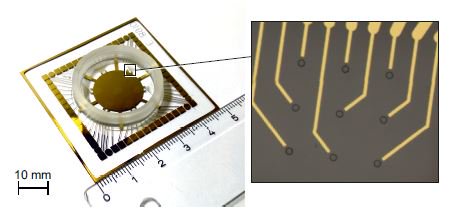*thread alert*
It's time for "transparent graphene microelectrodes to see how cells chit chat" 😁
Let go! 🍀🙂🤩
It's time for "transparent graphene microelectrodes to see how cells chit chat" 😁
Let go! 🍀🙂🤩
what is #graphene?
Here is the thread 👇
Here is the thread 👇
https://twitter.com/realscientists/status/993759854174097408
The produced #graphene needs to be transferred to our microelectrod arrays.
How does that work?
(left to right) graphene on Cu - see the hexagons? Yep, thats 2 or 3 layers of carbon atoms arranged in hexagonal lattice.
How does that work?
(left to right) graphene on Cu - see the hexagons? Yep, thats 2 or 3 layers of carbon atoms arranged in hexagonal lattice.

middle pictue ☝️graphene (darker) transferred on Au conduction paths (bright defined lines).
The bright stops are defects in graphene cause hey, nothings perfect. 🤪
The bright stops are defects in graphene cause hey, nothings perfect. 🤪
Rightmost picture - this one is after graphene structuring. Dark discs are graphene microelectrodes of 30 µm diameter and bright lines are Au conduction paths.
right - ready to use electrode field with 9 graphene electrodes.
left - MEA all ready and comfy for the cells to come and sit, grow, beat.
left - MEA all ready and comfy for the cells to come and sit, grow, beat.

See see! Them cells are beating! Not in the body but in the lab.
How cool is that?! 😁
How cool is that?! 😁
We at the @nmi_DE also work with retinas.
Transparency of these graphene microelectrodes can be super duper useful for Retina research.
Here 👇 is one such MEA about to host a mouse retina.
Transparency of these graphene microelectrodes can be super duper useful for Retina research.
Here 👇 is one such MEA about to host a mouse retina.
https://twitter.com/MySci_PK/status/962448095094235136
Taadaaaa!
See those green blops? Those are neurons. Those are the kind of cells our brain are made of.
Brain-cells!
That on blop on the circle is why we need transparent electrodes!
See those green blops? Those are neurons. Those are the kind of cells our brain are made of.
Brain-cells!
That on blop on the circle is why we need transparent electrodes!

cells are happy to sit and grow on the comfy #graphene microelectrodes
The bear being the cells and snow the microelectrode array.
The bear being the cells and snow the microelectrode array.
The #graphene electrodes are happy to host the cells and in return grab all the electrical activity.
Humans are happy cause we can spy on the cells while they chit chat with each other.
You are (hopefully) happy cause now you know how the cells beat in the lab, what neurons look like and AND, how to spy on the cells.
Feel free to use this knowledge to enlighten your favourite people.
Feel free to use this knowledge to enlighten your favourite people.
If you have questions about the cells, MEAs and spy stuff then hit me up - @MySci_PK
I will try to answer your questions and get our experts at the @NMI_DE to explain stuff to ya all 😁
I will try to answer your questions and get our experts at the @NMI_DE to explain stuff to ya all 😁
Thank you for reading till the end!
I hope you learnt something new and remember how the heart and brain cells look like. 🤪
I hope you learnt something new and remember how the heart and brain cells look like. 🤪
• • •
Missing some Tweet in this thread? You can try to
force a refresh





